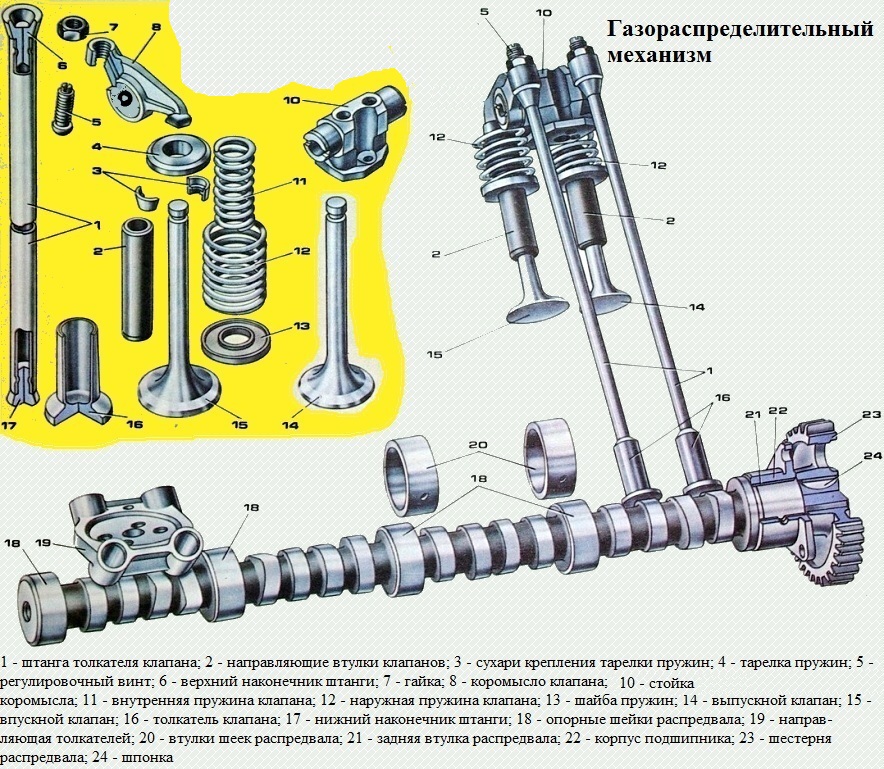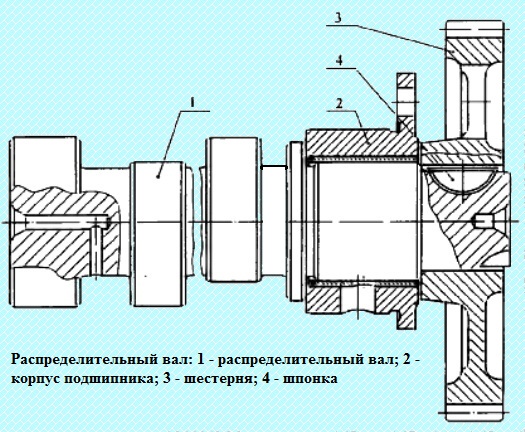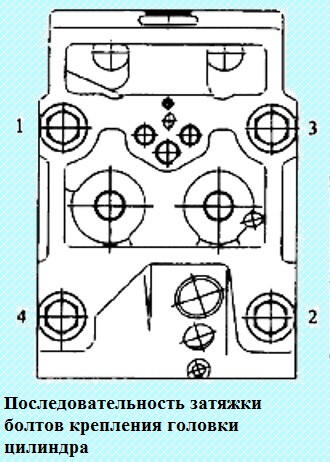The gas distribution mechanism is designed to ensure the intake of fresh air charge into the cylinders and the release of exhaust gases from them
The inlet and outlet valves open and close in certain positions of the piston, which is ensured by the alignment of the marks on the gears of the drive units during their installation.

The gas distribution mechanism is an overhead valve with a lower camshaft.
The camshaft cams 24, in accordance with the valve timing, actuate the pushers 23. The rods 18 impart a rocking motion to the rocker arms 16, and they, overcoming the resistance of the springs 7 and 8, open the valves 25. The valves close under the action of the compression force of the springs.

Steel camshaft, cams and bearing journals subjected to HDTV heat treatment; is installed in the collapse of the cylinder block on five plain bearings, which are steel bushings filled with an anti-friction alloy.
The diameter of the bushings is 6 mm larger compared to the motor bushings mod. 740.10.
Camshaft of increased dimension, modified valve timing and valve travel compared to the engine camshaft mod. 740.10.

Spur gear 3 is pressed onto the rear end of the camshaft.
The camshaft is driven by the crankshaft gear through the intermediate gears.
Steel gears, stamped with heat-treated teeth.
To ensure the specified valve timing, the gears are assembled during assembly according to the marks stamped on the ends (see the article "Technical characteristic of the KAMAZ 740.11-240 engine").
The shaft is fixed from axial movement by the housing 2 of the rear support bearing, which is attached to the cylinder block with three bolts.
The bore diameter of the rear support bearing housing is larger compared to the motor bearing housing mod. 740.10.
Installing the bearing housing of the rear camshaft support of the engine mod. 740.10 is not allowed, as it will lead to an emergency decrease in oil pressure in the system and premature failure of the engine.
Valves in heat-resistant steel.
The angle of the working chamfer of the valves is 90°. The diameter of the inlet valve plate is 51.6 mm, the exhaust valve is 46.6 mm, the intake valve lift is 14.2 mm, the exhaust valve is 13.7 mm.
The geometry of the plates of the inlet and outlet valves provides the appropriate gas-dynamic parameters of the inlet and outlet of gases and therefore their replacement with engine valves mod. 740.10 is not recommended.
The valves move in guide bushings made of sintered metal.
To prevent oil from entering the cylinder and reduce its consumption for waste, rubber seals are installed on the valve guides.
Pushers of poppet type with a profiled guide part, made of steel with subsequent hardfacing of the poppet surface with chilled cast iron.
The pusher is subjected to chemical-thermal treatment.
The rocker arms are made of steel, forged, they are a two-arm lever with a ratio of 1.55 of the larger arm to the smaller one.
Intake and exhaust valve rocker arms are mounted on a common pillar and are fixed in the axial direction with a spring retainer.
Rocker arms for engine 740.11-240. in contrast to the rocker arms mod. 740.10, without bronze bushing.
The tappet guides are cast in one piece with the cylinder block.
Push rods are steel, hollow with pressed tips. The rods are 3 mm shorter than the engine rods mod. 740.10 and are not interchangeable with them.
The rocker arm is cast iron, its trunnions are heat treated with HDTV.
The diameter of the trunnions is 2 mm larger compared to the trunnions of the rocker arm rack of the engine mod. 740.10.
Valve springs are helical, installed two per valve.
Springs and have different winding directions. The wire diameter of the outer spring is 4.8 mm, the inner one is 3.5 mm.
The pre-set spring force is 355 N, the total working force is 821 N. The springs are interchangeable with the motor springs mod. 740.10.
For adjusting the gaps between the rocker tips and valves, see the Maintenance section.
Cylinder heads 1 (Fig.1) separate for each cylinder, made of aluminum alloy. The cylinder head has a cooling cavity communicating with the cooling cavity of the block.
To strengthen the bottom of the head, its thickness in the area of the exhaust channel has been increased and an additional rib has been made in comparison with the cylinder head of the engine mod. 740.10.
Each cylinder head is mounted on two dowel pins pressed into the cylinder block and secured with four alloy steel bolts.
One of the locating pins simultaneously serves as a sleeve for supplying oil to the lubrication of the rocker arms. The bushing is sealed with rubber rings.
In the head, in comparison with the head of the 740.10 engine, the hole for draining engine oil from under the valve cover to the rod cavity is enlarged.
The intake and exhaust ports are located on opposite sides of the cylinder head.
The inlet channel has a tangential profile to ensure the optimal rotational movement of the air charge, which determines the parameters of the working process and the environmental performance of the engine, therefore, the replacement with engine cylinder heads mod. 740.10 is not allowed.
Cast iron seats and sintered valve guides are pressed into the head.
The valve seats have an increased interference fit compared to the engine seats mod. 740.10, and fixed with a sharp edge.
Exhaust seat and valve profiled for less resistance to exhaust gas.
Application of exhaust valve mod. 740.10 is not recommended.
Joint "cylinder head - sleeve" (gas joint) - unlined (Fig. Gas joint).

A steel sealing ring 3 is pressed into the bored groove on the lower plane of the head. By means of this ring, the cylinder head is mounted on the shoulder of the sleeve.
The tightness of the seal is ensured by high precision machining of the mating surfaces of the sealing ring and cylinder liner 5.
The sealing ring additionally has a lead coating to compensate for the microroughness of the sealing surfaces.
To reduce harmful volumes, a fluoroplastic gasket is installed in the gas joint - filler 4.
Gasket - the filler is fixed on the protruding girdle of the gas joint ring due to the reverse cone with an interference fit.
The use of a filler gasket reduces specific fuel consumption and exhaust smoke. Single use spacer.
To seal the bypass channels of the coolant, sealing rings 2 made of silicone rubber are installed in the holes of the bottom of the head.
The space between the head and the block, the engine oil drain holes and the rod passage holes are sealed with a gasket 7 of the cylinder head made of heat-resistant rubber.

When assembling the engine, the cylinder head bolts should be tightened in three steps in the order of increasing numbers indicated in fig. 5
Torque values should be:
- 1 pass - up to 39-49 Nm (4-5 kgf.m);
- 2 stroke - up to 98-127 Nm (10-13 kgf.m);
- 3 stroke - up to 186-206 Nm (19-21 kgf.m
Before screwing in, lubricate the threads of the bolts with a layer of graphite grease.
After tightening the bolts, it is necessary to adjust the clearances between the valves and rockers (adjustment of valve clearances is described in the article - General information about maintenance of the Kamaz engine.
The valve mechanism is covered with an aluminum cover 15 (see Fig.1). Vibration-isolating washer 14 and rubber sealing gasket 19 were used for noise insulation and sealing of the cover-cylinder head joint.
Tighten the cylinder head cover bolts with a torque of 12.7-17.6 Nm (1.3-1.8 kgf.m).
The main malfunctions of the gas distribution mechanism
Deviations in the operation of the gas distribution mechanism during natural weare parts cause a deterioration in the dynamics of the mechanism, contribute to accelerated wear of the mates. Of the total number of failures of all engine systems, 25-27% falls on the timing.
The main engine malfunctions caused by timing failures can be the following:
- - decrease in engine power, increase in fuel and oil consumption;
- - increase in exhaust smoke;
- - decrease in oil pressure in the engine system at temperatures above 0 ° C;
- - unstable engine idling;
- - engine operation with interruptions or overheating;
- - liquid leakage in the cooling system connections.
Signs of timing problems are knocks in the cylinder head.
A loud knock in the cylinder head is caused by the knock of valves on the rocker arms due to the large thermal gap between the valve and the toe of the rocker arm.
A dull metallic knock at idle and an increase in fuel delivery is a sign of broken valve springs or stuck valves.
Loose fit of the valve on the seat occurs when there is no or a decrease in the thermal gap between the toe of the rocker arm and the valve, as well as when the bearing capacity of the fixed connection between the cylinder head and the valve seat is violated.
When the valve does not fit snugly on the seat, gaps form in some areas between the valve and the seat.
Incandescent gases under pressure and at high speed pass into the cracks formed, so the surfaces of the chamfer in this place are intensively corroded, the fit of the chamfer to the seat deteriorates.
Combustion products accumulate on the surface of the chamfer, as a result of which the tightness of the joint is broken.
Analysis of characteristic damage to valves and their seats shows that approximately 90% of all damage occurs when the seat-valve connection is leaking.
With an increase in the thermal gap, the valve lift decreases, as a result of which the filling and cleaning of the cylinders worsens, shock loads and wear of timing parts increase.
With very small thermal gaps, as a result of combustion or wear of the working chamfers of the valve or valve seat, the tightness of the combustion chamber is not ensured, the engine loses compression, overheats and does not develop full power.
The most common timing failures are as follows:
- - premature wear of the seat and valve seating surfaces; valve guide wear;
- - violation of the stability of the fit in the valve seat - cylinder head interface;
- – deformation of the cylinder head;
- – valve seat and stem deformation;
- – valve disc deformation; valve stem breakage and corrosion; wear of holes for pushers;
- - wear of the camshaft bushings; wear of the camshaft cams; valve rocker wear.
Before performing maintenance, it is necessary to individually monitor the state of the timing, which allows using special equipment, without disassembling the engine, to identify the above hidden faults in advance and determine the list of preventive and repair actions.
The technical condition of the timing should be assessed by diagnostic parameters, and the need to perform maintenance and repair operations should be determined by the limit values of these parameters.
A characteristic defect of the rods: loose fitting of the tips and curvature of the rod rod.
The characteristic defects of valves are wear of the working chamfers, curvature of the stem, breakage of the valve disc, wear of the valve end
The characteristic defects of the pushers are the wear of the plate, the sink on the working surface, the wear of the rod
Worn out plates and pusher rods are restored by chrome plating.
After restoration, the valves are ground in the seats of the cylinder heads.





